The circulation pump in heating systems significantly improves space heating, accelerating the heat transfer process and creating uniform heating in all areas heating system. The main purpose of a circulation pump for a heating system is to create a flow of water through pipelines, preventing overheating of the liquid in the boiler and providing accelerated transportation to remote heat exchangers. Pumps for heating are produced by various manufacturers and differ in connecting dimensions, motor power, performance, maximum outlet pressure.
Device, components
Circulation pumps for heating systems include a unit housing, an electric motor, an impeller.
Most modern models the body of the device is attached to the engine. The impeller is put on the motor shaft. Using such a scheme allows you to minimize the size.
On the body there are suction and pressure connecting pipes with threaded or flanged connection. For a threaded connection, union nuts with fittings are included in the package. With a flange connection, the pump is connected via mating flanges.
On the electric motor there is a box for connecting the cable, a rotation speed switch. Speed control allows you to choose the most favorable mode of heating the house with energy savings.
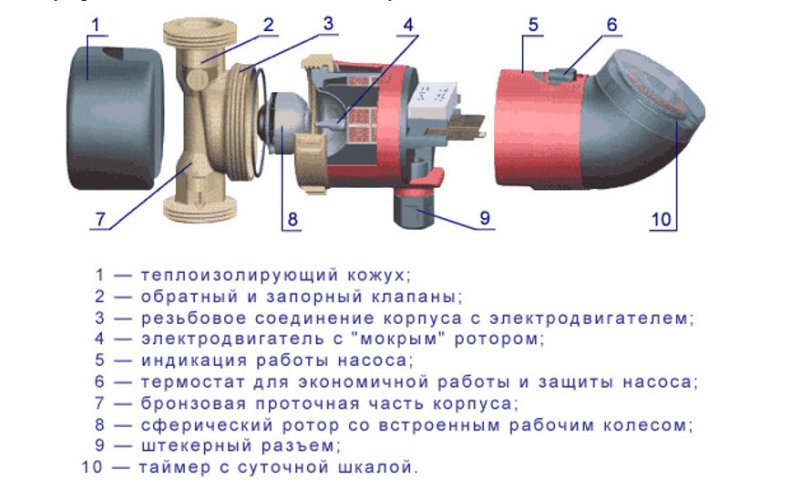
Depending on the device of the electric motor, pumps for heating are divided into 2 groups:
- water cooling of the electric motor;
- air cooling of the unit with an impeller.
Circulation pump for heating water-cooled motor has insulated windings. Water circulates in the gaps between the rotor and the windings. In the center back cover the electric motor has a special hole for removing air. This design ensures virtually silent operation.
The water pump for air-cooled heating contains special sealing cuffs on the motor shaft, gaskets between the housings to prevent water from entering the current-carrying parts. The noise level of this type of units is higher. Recommended for use in industrial premises and boiler rooms located separately from residential premises. The choice of a circulation pump for heating should be carried out according to certain parameters.
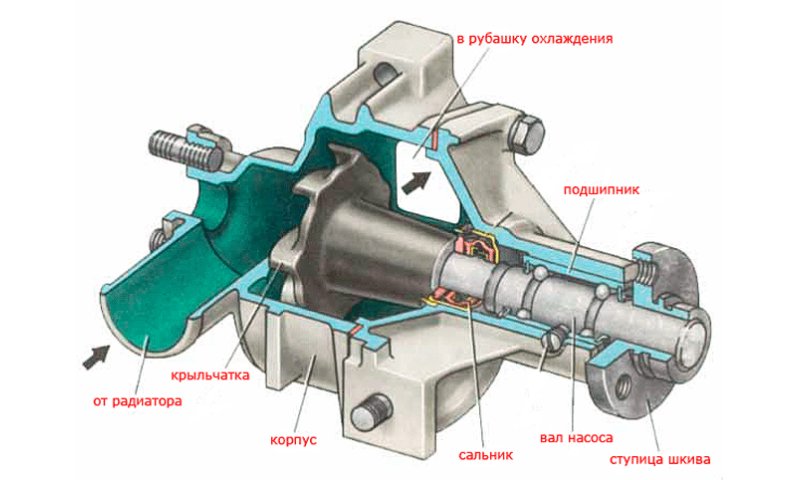
Criterias of choice
The selection of a circulation pump for the system begins with determining the heat consumed by the room. For calculation, use the standard value - 1 kW is required for heating 10m 2. For example, take a house with an area of 150m 2, the amount of heat will be 15 kW. Performance calculation:
G = Q / ,
- Q is the amount of heat (W);
- 1.16W*h/kg*С - value of specific heat capacity of water;
- T max - maximum temperature;
- Tmin - minimum temperature.
The temperature difference is 20˚ for heating radiators.
15000/1.16*20 = 646.55 kg/h
The performance of the pumps is indicated in m 3 / hour.
646.55 / 971.8 \u003d 0.665m 3 / h
According to the calculation, a heating pump with a flow rate of at least 0.8 m 3 / hour is required.

The next important parameter is pressure, or pressure. There is a formula for accurately calculating the required pressure, according to which the pump is selected. To determine, you will need passport data for the components of the heating system, the calculation of pressure losses at bends, narrowings of the passage diameter. How to correctly determine these values, even experts find it difficult. You can choose a circulation pump for heating by a simplified expression:
- R is the resistance to fluid movement of straight pipes;
- L is the size of the pipes of the system;
- ZF is a factor that takes into account the additional resistance of the system components.
How to choose the correct correction for a particular system? If ball valves, fittings, connections without internal diameter reduction are used, the value is 1.3. In the presence of a temperature controller in common pipelines, other constrictions, the coefficient is 1.7. The choice of the pump should be done with a margin up from the calculated value obtained.
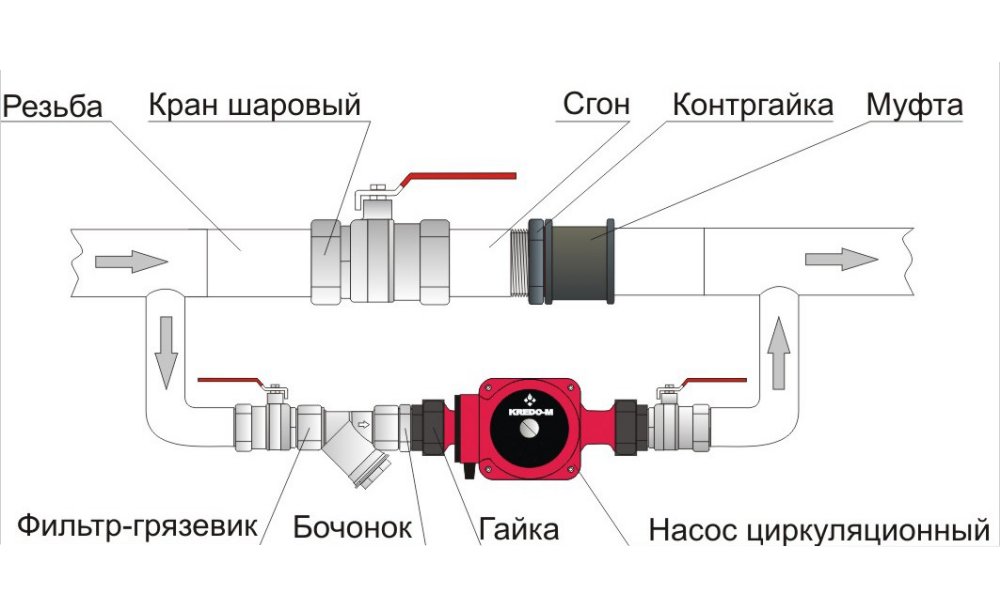
Selection, installation
The calculation of the circulation pump determines the main parameters of the unit. In addition to the calculated values, you should pay attention to the place where you want to install the pump. The dimensions and layout do not have the ability to arrange a separate room of the appropriate size for installing the pump in the heating system of a private house. The usual location in a space with difficult access, in the corners, along the walls. Before purchasing, you should review the documentation on how to properly position the device in a spatial position. Many heating pumps have restrictions on this item.
Must be taken into account dimensions devices so that the engine and other protruding parts do not rest against the walls.
In the area of connection points, the circulation unit for heating must have free space for capturing the nuts with wrenches, tightening or unscrewing them.
Connection to electrical network it is desirable to carry out through a plug-in connection of the plug-socket type with the installation protective devices RCD type and circuit breaker to the maximum admissible current. The supply line must have a ground wire. If not, local grounding should be arranged in accordance with the rules of the PUE.
The problem of how to choose a circulation pump is not so difficult. If you have some experience and knowledge, you can solve it yourself. If there is uncertainty in their capabilities, with the question of how to choose a pump for heating, you should contact the specialists. Many commercial enterprises have competent consultants on staff to help solve most problems. Consultations can be obtained by phone or by inviting specialists to your home.
For more efficient operation autonomous system heating requires a good circulation pump. The installation of such a unit is also welcome for residents of the upper floors in apartment buildings, where often the batteries do not receive enough hot water due to low pressure in system.
All problems are solved by using a circulation pump. Even if the heating system in a private house operates on natural circulation, a pump connected to the circuit will enhance the heat transfer of radiators and help reduce costs from the family budget.
Advantages of a pressure unit in a heating system:
- Fast system overclocking. Within a few minutes, the pump will accelerate the heating system, which will heat cold rooms in the shortest possible time.
- High efficiency. Installing a pump increases the efficiency of the entire heating system by several times, while reducing energy costs.
- Reliable performance. Manufacturers guarantee uninterrupted operation of the device for 20 years.
- Undemanding. The circulation pump solves the problem of counter-slopes and constricted and angular sections of the pipeline system. In the absence of natural circulation, the installation of such a device will be extremely mandatory.
The principle of operation of the pump
The unit is an engine with a rotor immersed in. The rotor during rotation causes the hot liquid to move through the system at a set speed, thereby increasing the pressure. Different modes of operation of the pump allow you to work wonders. So, by turning on the maximum mode, you can warm up the house that has cooled down in the absence of the owners in a short time. When the required temperature regime, the pump settings are restored and when minimum expenses maintain a comfortable microclimate in the premises.
There are two modifications of the circulation pump:
- wet - the motor rotor is completely immersed in the coolant;
- dry - with partial immersion in liquid.
Depending on the type and design of the heating system, one or another pump model is installed.
Calculation of pump parameters
The circulation pump has two functions:
- create pressure in the system that exceeds the hydraulic resistance of the elements and components of the system;
- ensure stable transportation of the volume of coolant required to heat the house.
For determining technical specifications necessary water unit, several calculations should be carried out to determine the total need of the premises of the house for thermal energy and the general parameter of the hydraulic resistance of the elements of the heating system.
Pump performance is calculated using a simple formula:
Q \u003d 0.86 * R / Tin - Tout, where:
Q - pump performance, m 3 / h;
R - required thermal power for all premises of the building, kW;
Tin – liquid temperature at the system inlet, ºС;
Тout – outlet temperature, ºС.
R can have different values. Usually, the following parameters are taken for calculations:
- 100 W / sq.m - for a small private house;
- 70 W / sq.m - for an apartment building;
- 50 kW / sq.m - for a building with a very high thermal insulation index.
To overcome the hydraulic resistance, the system must have a sufficient suction lift, denoted as "H". To calculate this indicator, you need to know the technical data of all elements of your system:
H \u003d 1.3 * (Z1 * L1 + Z2 * L2 + R1 + R2 + Zn) / 10000, where
- Z1, Z2 - pressure losses on the supply and return, Pa / m;
- L1, L2 - the length of the supply and return pipelines, m;
- R1, R2,…Rn – hydraulic resistance individual elements systems, Pa.
The values Z1 and Z2 are taken from the table:

For ease of calculation, you can use the approximate values of Z1 and Z2 for individual elements of the system:
Circulation pump speed control
Modern models of water pumps have a mechanism for adjusting the speed of the unit. Usually these are three-speed models that allow you to adjust the volume of coolant transported through the pipeline to maintain the required temperature.
A special lever is located on the pump housing, by means of which the required speed mode of the device is set. The newest models of such devices are equipped with an automatic speed control system. Sensors determine the temperature value in the rooms and switch the pump to the appropriate operating mode.

Some nuances when choosing a pump model
It was said above that pumps can be "dry" and "wet", with manual and automatic systems speed adjustments. Which model is better to choose?
Experience shows that the most preferred option is a water pump, the rotor of which is completely immersed in the coolant. The advantages of such a model are not only in the silent operation of the device, but also in the ability to more successfully cope with the load.
The production of high-quality pumps is carried out using durable types of steel, and ceramic shafts and bearings are used in the working units. A successfully purchased pump model will serve at least 20 years. Experts do not advise choosing devices with a cast-iron case, since such material quickly collapses in the aquatic environment. The ideal option pumps will be made of stainless steel, bronze and brass.
The appearance of noise during the operation of the unit does not always indicate its malfunction. Often the cause of such a nuisance is air that did not leave the system at startup. To restore operation, before starting the pump, bleed air from the system using special valves. After letting the system run for a few minutes, repeat this operation again and adjust the pump operation mode.
When choosing circulation pumping equipment, preference should be given to companies that have long established themselves in the market thermal equipment. Products from companies such as Grundfos and Wilo have a fairly high cost, but they are superior in quality to their counterparts. They are reliable and have high technical characteristics.
Heating systems are able to work on the natural circulation of the liquid. Under these conditions, the installation is carried out in such a way that the heated coolant goes into the system, and after the energy is released, it returns to the boiler cooled down. It will be possible to increase the efficiency of this scheme by installing a circulation hydraulic pump in the circuit.
Based on this, the circulation pump is an important component of the heating and hot water supply system. Due to its use, the working fluid moves with greater intensity along the lines from the heat generator (boiler of any type) to consumers (radiators or underfloor heating systems). Due to the closed circuit and the intensity of the pump, heat transfer increases.
Main settings
A modern circulation pump is a device similar in principle to working with drainage pump. At the same time, in most models, the body is made of the following materials:
- bronze;
- brass;
- cast iron;
- aluminum alloys.
The use of these substances reduces the effect of corrosion on the operation process. A rotating rotor is often made using ceramic materials. On the rotor shaft is a wheel with blades - an impeller.
The principle of operation of a circulation pump for heating or any other type is that during the start, due to the rotation of the impeller, an area with reduced pressure is formed near the inlet pipe. Such a vacuum draws in a certain portion of the coolant, and overpressure injected at the outlet pipe. This is facilitated by the centrifugal force that is formed during the rotation of the impeller. This compression causes fluid to move through closed system heating or hot water supply.
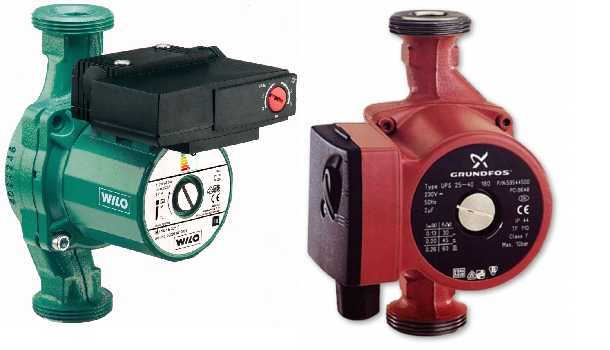
For effective work hydraulic apparatus requires the following structural elements:
- housing with two inlet and outlet nozzles;
- impeller with blades;
- DC motor.
Device types
To figure out which circulation pump is better, you need to know their varieties. There are two large groups into which all devices of this type are divided. There are circulation pumps with a wet rotor or dry. In each case, they have their own positive and negative properties. Manufacturing companies are constantly working to improve the performance of models of all types.
Wet rotor units
In devices of this type, the rotor is located in the liquid. Contacts are hidden in a special sleeve made of stainless steel.

During engine operation, additional grinding of the rings is carried out, which only increases the hermetic properties of the assembly.
Such an engineering solution uses a coolant in the form of a lubricant. The circulation pump with a wet rotor can be equipped with one of the types of electric motors:
- single-phase;
- three-phase.
The power of the appliance is selected accordingly structural features apparatus. The inlet and outlet pipe is equipped with threaded connections or flanged ones, which make it easy to quickly mount the circuit for connecting the circulation pump.
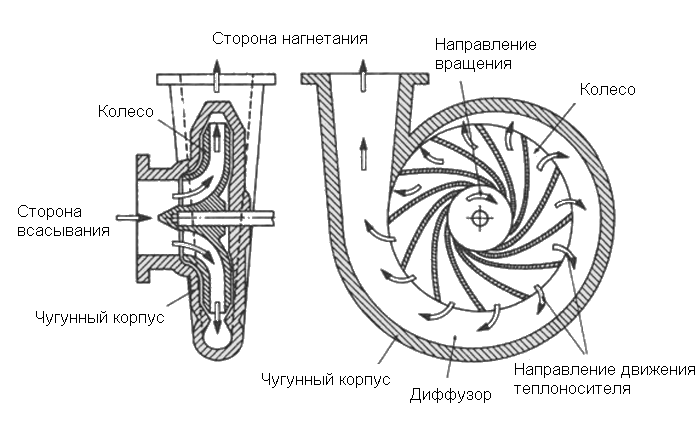
The principle of operation of equipment with a wet rotor
The positive properties of this design are the following characteristics:
- small parameters and weight;
- low noise properties;
- minimum voltage consumption;
- long time uninterrupted operation;
- ease of setup and a high degree of maintainability.
If the circulation pump in the heating system does not work, then this is easy to fix by replacing the damaged module.
The main disadvantage of a wet rotor apparatus is its low efficiency, which does not always reach 50%. This problem is more typical for large-sized devices with large-diameter rotors.
When mounting circulation pumps, the strict horizontality of the rotor shaft must be observed. This rule will ensure that the water lubricant is evenly distributed over the sleeve to the rolling bearings.
VIDEO: Installation of a Grundfos circulation pump with a wet rotor
Use of dry rotors
The rotor in pumps of this type was structurally separated by engineers with sealing rings made of ceramic or metal with high friction properties. During operation, the rings rotate relative to each other. A very thin water film remains in the narrow gap between the two surfaces of the rings. It helps to seal the assembly from the rest of the structure. Due to the pressure difference, the liquid does not flow to the rotor.
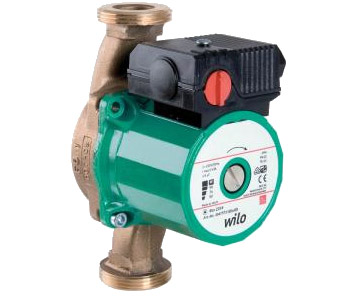
Constant grinding of the rings increases their wear, but a block of springs helps to reduce this factor, regularly pressing them against each other, minimizing gaps.
This type of apparatus has a higher efficiency, which reaches 80%. However, the design is not without certain disadvantages:
- Wet motor pumps are noisier than their counterparts and often require additional soundproofing.
- special requirements for the purity of the liquid used, since any contamination can violate the tightness of the pairing of the rings.
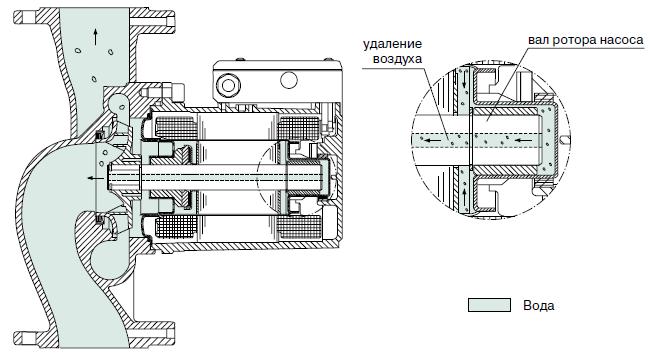
Scheme of the "dry" rotor
There are the following types of dry pumps:
- vertical, in which the electric motor is installed vertically, and the working pipes are installed in a single axis;
- horizontal, in which the motor is mounted in a horizontal plane, the outlet is installed radially, and the inlet is on the end side of the volute;
- block, in them the coolant is started along the axis, and exits in the radial direction.
VIDEO: Disassembly and repair of the pressure booster pump Oasis CNP 15/9
Features of the installation of circulation pumps
In most cases, the installation of this hydraulic equipment carried out by experts. However, this approach does not prevent you from installing the device yourself in a heating or hot water supply circuit. In this case, certain rules must be observed.
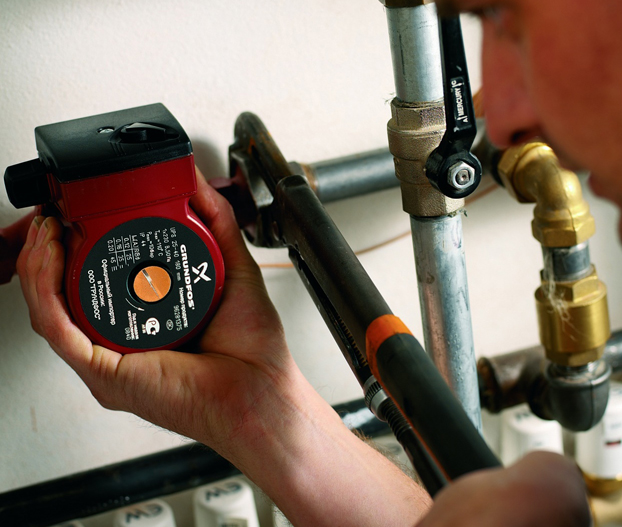
For installation, the least heated area with a coolant is selected - a return line that returns the cooled liquid to the boiler. For small rooms, area 200 square meters and less, this rule is rather a convention, since the temperature of the liquid at the inlet and outlet differs only by 2-3 0 C.
Be sure to observe the flow direction during installation in the diagram. It is indicated by an arrow on the pump housing. Shut-off valves are mounted on both sides of the pump, and a coarse filter is installed in front of the inlet pipe. Reliability threaded connections completed with sealants. After the pump is installed in a horizontal position, the coolant is poured into the housing, and excess air is removed using a central screw.
During the installation of the circulation pump in heating systems using combined circulation, a bypass must be installed (pipe with shutoff valves). It will help, if repair or preventive maintenance of the pump is necessary, to let the coolant through the system due to the natural circulation of the liquid.
The cost of pumps often depends on their power characteristics. The approximate price is 65-215 $. The most popular models are products trademarks Wester, Grundfos, Pedrollo, Halm. Almost all of them have high performance characteristics. domestic producers household appliances do not produce, but focus on industrial products.
VIDEO: Installation of circulation GRUNDFOS pump into the heating system. Bypass installation
Traditionally, water heating systems were built on the principle of natural water circulation. In old houses you can see that horizontal pipes go downhill. The principle of operation is the same as in the kettle. Hot water rises, cold water flows down.
The efficiency of such circuits is low due to the high water resistance in the pipes. If an air lock formed along the path of the coolant, the process could stop altogether. Therefore, for heating the house with gravity systems, pipes were installed large diameter. It was not aesthetically pleasing and expensive.
note
Information: A similar scheme was used only in the case of installing the boiler directly in the house. With centralized heating, hot water moves through the heating main only with the help of a pump.
For small rooms, such a system is applicable; the coolant will pass a short distance through thin pipes. Therefore, for small country houses use self-driving. True, warming up the entire system takes a long time. If you have three or four rooms, especially on different floors, a circulation pump for the boiler is necessary.
Otherwise, you will have to wait for the diffusion effect to work. In this case, the heat will spread through the pipes at a rate of 10 cm per hour.
What is a circulation pump for heating
In essence, this is a common water pump bladed (turbine) type. There are piston pumps, but they are not used for heating systems.
Inside there is an impeller, which is driven by an electric motor. During rotation, there is a difference in pressure between the nozzles, and the liquid flows in one direction.
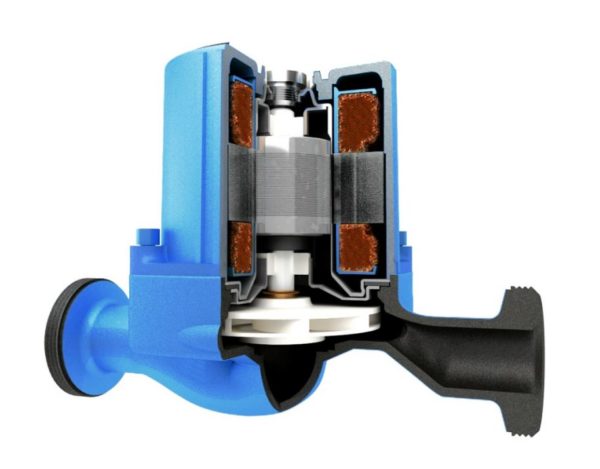
The pump is running at high temperatures coolant, so the materials must be heat-resistant and resistant to corrosion:
- aluminum
- bronze
- cast iron
- stainless steel
There are cases made of composite materials - but this is a different price category.
The turbine impeller is made of special polymers. The calculation is for long-term operation, few people want to regularly disassemble the heating system to replace pump components.
Designs and sizes are very diverse, will not be great work choose the right copy. However, the difference is not only in appearance.
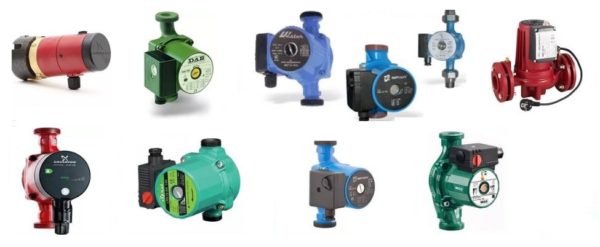
Water Pump - Design Differences
Bleeding pumps, with all the richness of choice, are divided into two categories:
dry rotor
A characteristic difference is immediately noticeable - the engine is clearly separated from the transfer chamber.
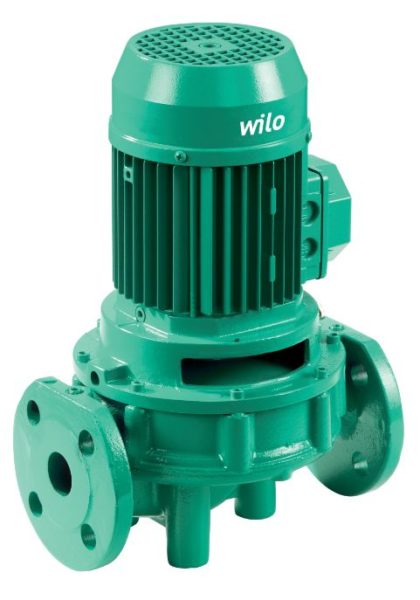
The design provides for the separation of the working turbine and drive. Only the impeller comes into direct contact with the water. The engine is located outside, and is connected to the water chamber by a long shaft. Tightness is provided by seals - like those that are installed on the propeller shafts of ships.
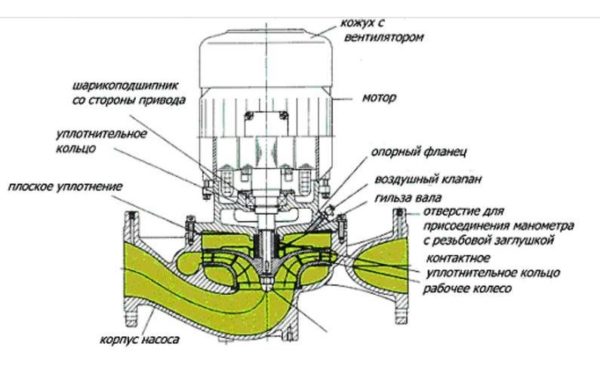
The advantages of the system are high efficiency. IN best models reaches 80%. If you need a powerful pump for an extensive system, this will be right choice. For pumping a large volume of coolant, the cost of electricity will be lower.
There are also disadvantages, and not a few. Such a pump produces a lot of noise, so it should not be installed in a residential area, only in separate boiler rooms. The motor overheats during continuous operation.
Requires a case radiator that increases the dimensions. Vulnerable place - seals. Under the influence of hot water and small grains of calcium, gum tan and quickly fail.
Therefore, a dry pump requires maintenance after each heating season. If you miss a leak, water can get on the motor windings. The average service life is 3 seasons.
wet rotor
The main advantage is compactness and neat appearance.
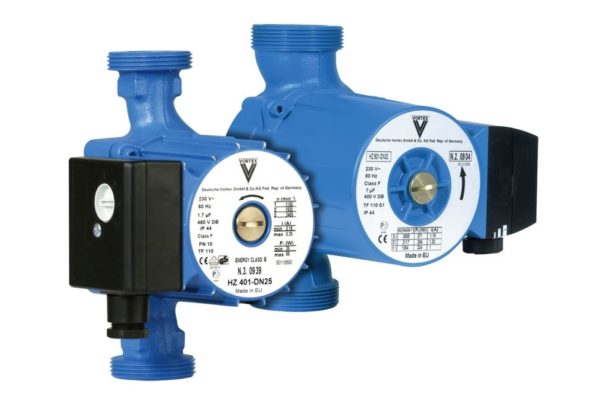
The motor rotor together with the impeller "baths" in the pumping chamber. This design provides good heat dissipation (despite the carrier temperature) and bearing lubrication.

note
For your information: Those who doubt the lubricating properties of water, let them remember the design of the water pump of an automobile motor.
The electrical part is located in a separate section, and is completely protected from moisture.
Works almost silently. This parameter is decisive when choosing a circulation pump for home ownership. In addition, the pump is maintenance-free. It works on the principle: set it and forget it. Service life 6-8 years. The device is compact, especially in comparison with the previous category.
The only drawback is low efficiency. Efficiency rarely reaches 50%. However, for a small cottage or apartment, the pump power is quite sufficient.
How to choose a circulation pump
Appearance and dimensions can hardly become a determining criterion. Boiler equipment is not installed in the front living room, and the circulation pump can be installed in almost any part of the heating circuit.

The main parameters that interest the buyer
Performance
For ease of calculation, it is linearly tied to the boiler power. Each kilowatt must be provided by pumping 1 liter per minute. That is, if the power of your boiler is 50 kW, choose a pump capacity of at least 50 l / min.
If the weather in your region is unstable, that is, warming may come sharply in winter, or April frosts will come, the recirculation pump must have a speed controller. The faster the coolant moves through the pipes, the higher the heat transfer. The performance of the boiler can not be changed.
Water boost pressure
The calculation of the circulation pump depends on the number of storeys of the house. To run water along one level, regardless of the length of the heating system, 1.5-2 atmospheres are enough. Each successive floor doubles the value. That is, for a typical two-storey cottage with a warm attic, the back pressure should be at least 4 atmospheres.
Temperature regime
The technical characteristics of the heating pump imply work with a hot coolant (at least from the point of view of common sense). However, water temperature varies, and pump manufacturers save on materials.
Therefore, one must look at maximum temperature which guarantees uninterrupted operation. Having bought a pump, stick to the heating mode. The temperature at the outlet of the boiler must be 10% lower than the maximum for the pump.
Circulation pump - installation diagram
You can not just stick the turbine into the pipe cut, and turn on the power. To install a pump, you need to know how your heating system works.
It is single-pipe, when the radiator pipes are simply removed from main pipe at some distance. Such a system is used in low-rise buildings of Soviet construction.

With this inclusion, a small pump power is required, a speed controller is not needed. Suitable for climates with smooth transitions from season to season. The system is inert and economical.
A two-pipe system works differently.
The coolant is supplied to the radiators through one pipe, after cooling it is discharged through the return pipe. Requires a powerful pump with speed control. The advantage is that the system heats up quickly, but it requires more energy.
How to install the circulation pump correctly when the installation site is selected
The main rule is to provide a bypass, that is, a workaround.

Three shut-off valves are required.
Important! Cranes must be designed for hot water. Otherwise, the mechanism will quickly give backlash, and leaks are guaranteed.
The main task is to provide an emergency bypass of water in the event of a pump breakdown. In addition, you can run water directly to dismantle the appliance, without draining the coolant from the system.
Installing a circulation pump with your own hands is no more difficult than changing a faucet in the bathroom. The main thing is to prepare the pipes "dry". Pay attention to the quality of the gaskets. If a leak is found after filling the system, you will have to drain all the water and redo the faulty connection.
Another trick - it is recommended to install the circulation pump horizontally, with the engine up. For dry rotor systems, this is mandatory requirement. In this case, if the flange connection leaks, the electrical part of the motor will not be flooded with water. It is desirable that no other connections are located above the pump.
After reading this material, you will be able to choose the right pump, or control the installer team. At a minimum, the validity of the proposed model.
Video review of circulation pumps will help you make the right choice








